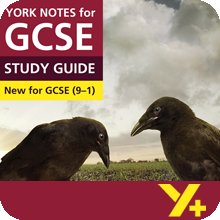Examiner's Notes
You assessed this answer as Grades 6–7.
Hover over the highlighted text to read the examiner’s comments.
How does Orwell use the character of Boxer to explore ideas about power in Animal Farm?
Write about:
- what Boxer says and does
- how Orwell uses the character of Boxer to explore ideas about power.
Boxer represents all that is good in Orwell’s novella. Our first introduction to him emphasises both his physical power (he has ‘vast hairy hoofs’ and is as strong ‘as any two ordinary horses put together’) but also that this ‘enormous beast’ is a gentle one: he sets his hoofs ‘with great care’ to avoid hurting any smaller creatures who might be hidden in the straw. Boxer represents, in allegorical form, the purity and virtue of the working man, who in Orwell’s eyes is cruelly exploited by both the capitalist system and corrupt political leaders, such as Stalin.
Boxer’s strength and physical power is repeatedly mentioned in the story. He is the ‘admiration of everybody’ on the farm but seems to acquire almost superhuman powers once the revolution is achieved: he seems to be ‘more like three horses than one’. The farm is utterly dependent on him: its ‘entire work’ seems to ‘rest upon his mighty shoulders’. Not only does he help to bring in the harvest on time – his ‘tremendous muscles’ pull the farm through – but his physical strength and dedication are also central to the success of the building (and rebuilding) of the windmill.
Boxer is loyal in every sense. He is also one of the main defenders of the farm from attack. He is a ‘terrifying spectacle’ rearing up and ‘striking out with his great ironshod hoofs’. Orwell makes clear that Boxer’s ‘terrifying’ power is only ever a force for good: even when fighting for the survival of the farm, Boxer ‘sorrowfully’ mourns the apparent death of the stable-lad. Orwell is also careful to tell us that this act of violence is not deliberate: ‘I forgot that I was wearing iron shoes. Who will believe that I did not do this on purpose?’ This contrasts with the calculated terror we see Napoleon dispense during the rest of the story but also shows Orwell’s refusal to present Boxer as anything other than saintly. Even in self-defence Boxer’s power is benign. And, of course, he turns out not to have killed the stable-lad after all.
In fact, Boxer is placed so far beyond reproach that at times Orwell’s depiction of his selflessness almost feels exaggerated. Even when he collapses with a damaged lung, Boxer’s first thought is for the farm, telling the other animals that he has gathered enough stone for them to rebuild the windmill. Orwell presents him as a paragon of virtue as he is the true hero of the story – the blame-free working man whose trusting, honest nature is exploited by unscrupulous political leaders. While Boxer represents the Stakhanovite workers whose effort and sacrifice was celebrated by the Soviet Union, the book’s subtitle (‘A Fairy Story’) should also be taken into account. Perhaps this is one reason why at times Boxer feels a little one-dimensional – you don’t get complex characters in fairy tales, after all.
Boxer has a single weakness. Boxer’s lack of intelligence means that he never gets beyond his ‘ABCD’. Orwell suggests that physical power is of no use here: Boxer tries ‘with all his might’ to remember the rest of the alphabet but can never do so. Orwell suggests that this, coupled with his trusting nature, makes him vulnerable to exploitation. When Snowball is expelled from the farm, Boxer is ‘vaguely troubled’ but cannot articulate his concerns – or, as ‘vaguely’ suggests, even pinpoint what those concerns are. He tries hard ‘to marshall his thoughts’ but cannot ‘think of anything to say’. He eventually settles for trusting his leader rather than questioning him: ‘from then on he adopted the maxim ‘Napoleon is always right’.
